Overview
When writing applications in the Standard Widget Toolkit (SWT),
you may need to use layouts to give your windows a specific look.
A layout controls the position and size of children in a Composite.
Layout classes are subclasses of the abstract class Layout.
SWT provides several standard layout classes, and you can write custom
layout classes.
In SWT, positioning and sizing does not happen automatically.
Applications can decide to size and place a Composite's
children initially, or in a resize listener. Another option is to
specify a layout class to position and size the children. If children
are not given a size, they will have zero size and they cannot be seen.
The diagram below illustrates a few general terms that are used
when discussing layouts. The Composite (in this case, a TabFolder)
has a location, clientArea and trim. The size of
the Composite is the size of the clientArea plus the
size of the trim. This Composite has two
children that are laid out side by side. A Layout is
managing the size and position of the children. This Layout
allows spacing between the children, and a margin
between the children and the edges of the Layout. The size
of the Layout is the same as the size of the Composite's
clientArea.
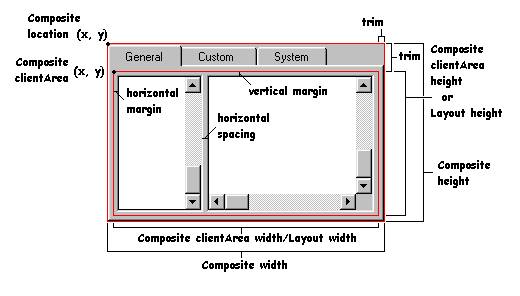
The preferred size of a widget is the minimum size needed
to show its content. In the case of a Composite, the
preferred size is the smallest rectangle that contains all of its
children. If children have been positioned by the application, the Composite
computes its own preferred size based on the size and position of the
children. If a Composite is using a layout class to
position its children, it asks the Layout to compute the
size of its clientArea, and then it adds in the trim
to determine its preferred size.
Standard Layouts
The standard layout classes in the SWT library are:
FillLayoutlays out equal-sized widgets in a single row or columnRowLayoutlays out widgets in a row or rows, with fill, wrap, and spacing optionsGridLayoutlays out widgets in a gridFormLayoutlays out widgets by creating attachments for each of their sides
To use the standard layouts, you need to import the SWT layout package:
import org.eclipse.swt.layout.*;
Layouts are pluggable. To set a Composite widget's
layout, you use the widget's setLayout(Layout) method. In
the following code, a Shell (a subclass of Composite)
is told to position its children using a RowLayout:
Shell shell = new Shell(); shell.setLayout(new RowLayout());
A layout class may have a corresponding layout data class: a
subclass of Object that contains layout data for a specific
child. By convention, layout data classes are identified by substituting
"Data" for "Layout" in the class name. For example,
the standard layout class RowLayout has a layout data class
called RowData, the layout class GridLayout
uses a layout data class called GridData, and the layout
class FormLayout has a layout data class called FormData.
A widget's layout data class is set as follows:
Button button = new Button(shell, SWT.PUSH); button.setLayoutData(new RowData(50, 40));
Examples in this Document
Most of the snapshots in this document were taken by running variations on the following example code. We may change the type of layout, the options used, or the type or number of children.
import org.eclipse.swt.SWT;
import org.eclipse.swt.layout.RowLayout;
import org.eclipse.swt.widgets.Button;
import org.eclipse.swt.widgets.Display;
import org.eclipse.swt.widgets.Shell;
public class LayoutExample {
public static void main(String[] args) {
Display display = new Display();
Shell shell = new Shell(display);
// Create the layout.
RowLayout layout = new RowLayout();
// Optionally set layout fields.
layout.wrap = true;
// Set the layout into the composite.
shell.setLayout(layout);
// Create the children of the composite.
new Button(shell, SWT.PUSH).setText("B1");
new Button(shell, SWT.PUSH).setText("Wide Button 2");
new Button(shell, SWT.PUSH).setText("Button 3");
shell.pack();
shell.open();
while (!shell.isDisposed()) {
if (!display.readAndDispatch()) display.sleep();
}
}
}
Running the above code results in the following:

If the user resizes the shell so that there is no longer room for
Button 3 on the right, the RowLayout wraps Button 3 to the
next row, as follows:

Using layouts is closely tied with resize, as we shall see.
Consequently, most of the examples in this document show what would
happen if the Composite becomes smaller or larger, in order
to illustrate how the Layout works.
FillLayout
FillLayout is the simplest layout class. It lays out
widgets in a single row or column, forcing them to be the same size.
Initially, the widgets will all be as tall as the tallest widget, and as
wide as the widest. FillLayout does not wrap, and you
cannot specify margins or spacing. You might use it to lay out buttons
in a task bar or tool bar, or to stack checkboxes in a Group.
FillLayout can also be used when a Composite
only has one child. For example, if a Shell has a single Group
child, FillLayout will cause the Group to
completely fill the Shell.
Here is the relevant portion of the example code. First we create
a FillLayout, then (if we want vertical) we set its type
field to SWT.VERTICAL, and set it into the Composite
(a Shell). The Shell has three push button
children, "B1", "Wide Button 2", and "Button
3". Note that in a FillLayout, children are always the
same size, and they fill all available space.
FillLayout fillLayout = new FillLayout();
fillLayout.type = SWT.VERTICAL;
shell.setLayout(fillLayout);
new Button(shell, SWT.PUSH).setText("B1");
new Button(shell, SWT.PUSH).setText("Wide Button 2");
new Button(shell, SWT.PUSH).setText("Button 3");
The following table shows the differences between a horizontal
and vertical FillLayout, initially and after the parent has
grown.
|
Initial |
After resize |
|
fillLayout.type = SWT.HORIZONTAL
(default) |
 |
 |
fillLayout.type = SWT.VERTICAL |
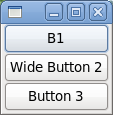 |
 |
RowLayout
RowLayout is more commonly used than FillLayout
because of its ability to wrap, and because it provides configurable
margins and spacing. RowLayout has a number of
configuration fields. In addition, the height and width of each widget
in a RowLayout can be specified by setting the widget's RowData
object using setLayoutData.
RowLayoutConfiguration Fields
The type field controls whether the RowLayout
lays out widgets in horizontal rows, or vertical columns. RowLayouts
are horizontal by default.
The wrap field controls whether or not the RowLayout
will wrap widgets into the next row if there isn't enough space in the
current row. RowLayouts wrap by default.
If the pack field is true, widgets in a RowLayout
will take their natural size ("natural size" varies by widget;
the natural size for a label or push button, for example, is large enough to
display its textual contents), and they will be aligned as far to the
left as possible. If pack is false, widgets will fill the available
space, similar to the widgets in a FillLayout. RowLayouts
pack by default.
If the justify field is true, widgets in a RowLayout
are spread across the available space from left to right. If the parent
Composite grows wider, the extra space is distributed
evenly among the widgets. If both pack and justify
are true, widgets take their natural size, and the extra space is placed
between the widgets in order to keep them fully justified. By default, RowLayouts
do not justify.
The marginLeft, marginTop, marginRight,
marginBottom and spacing fields control the
number of pixels between widgets (spacing) and the number
of pixels between a widget and the side of the parent Composite
(margin). By default, RowLayouts leave 3 pixels for margins
and spacing. The margin and spacing fields are shown in the following
diagram.

RowLayout Examples
The following example code creates a RowLayout, sets
all of its fields to non-default values, and then sets it into a Shell.
RowLayout rowLayout = new RowLayout(); rowLayout.wrap = false; rowLayout.pack = false; rowLayout.justify = true; rowLayout.type = SWT.VERTICAL; rowLayout.marginLeft = 5; rowLayout.marginTop = 5; rowLayout.marginRight = 5; rowLayout.marginBottom = 5; rowLayout.spacing = 0; shell.setLayout(rowLayout);
If you are using the default field values, you only need one line of code:
shell.setLayout(new RowLayout());
The results of setting specific fields is shown below:
|
Initial |
After resize |
|
rowLayout.wrap = true; rowLayout.pack = true; rowLayout.justify = false; rowLayout.type = SWT.HORIZONTAL; (defaults) |
 |
 and  |
wrap = false (clips if not enough space) |
 |
 |
pack = false (all widgets are the same size) |
 |
 |
justify = true (widgets are spread across the available space) |
 |
 |
type = SWT.VERTICAL (widgets are arranged vertically in columns) |
 |
 |
Using RowData Objects with RowLayout
Each widget controlled by a RowLayout can have its
initial width and height specified by setting its RowData
object. The following code uses RowData objects to change
the initial size of the Buttons in a Shell.
package org.eclipse.articles.layouts.samples;
import org.eclipse.swt.SWT;
import org.eclipse.swt.layout.RowData;
import org.eclipse.swt.layout.RowLayout;
import org.eclipse.swt.widgets.Button;
import org.eclipse.swt.widgets.Display;
import org.eclipse.swt.widgets.Shell;
public class RowDataExample {
public static void main(String[] args) {
Display display = new Display();
Shell shell = new Shell(display);
shell.setLayout(new RowLayout());
Button button1 = new Button(shell, SWT.PUSH);
button1.setText("Button 1");
button1.setLayoutData(new RowData(50, 40));
Button button2 = new Button(shell, SWT.PUSH);
button2.setText("Button 2");
button2.setLayoutData(new RowData(50, 30));
Button button3 = new Button(shell, SWT.PUSH);
button3.setText("Button 3");
button3.setLayoutData(new RowData(50, 20));
shell.pack();
shell.open();
while (!shell.isDisposed()) {
if (!display.readAndDispatch())
display.sleep();
}
}
}
Here is what you see when you run this code.

GridLayout
With a GridLayout,
the widget children of a Composite are laid out in a grid.
GridLayout has a number of configuration fields, and—like
RowLayout—the widgets it lays out can have an associated
layout data object, called GridData. The power of GridLayout
lies in the ability to configure GridData for each widget
controlled by the GridLayout.
GridLayout Configuration Fields
The numColumns field is the most important field in
a GridLayout, and it is usually the first field an
application will set. Widgets are laid out in columns from left to
right, and a new row is created when numColumns + 1 widgets
are added to the Composite. The default is to have only 1
column. The following code creates a Shell with five Button
children of various widths, managed by a GridLayout. The
table below shows the grid when numColumns is set to one, two,
or three.
Display display = new Display();
Shell shell = new Shell(display);
GridLayout gridLayout = new GridLayout();
gridLayout.numColumns = 3;
shell.setLayout(gridLayout);
new Button(shell, SWT.PUSH).setText("B1");
new Button(shell, SWT.PUSH).setText("Wide Button 2");
new Button(shell, SWT.PUSH).setText("Button 3");
new Button(shell, SWT.PUSH).setText("B4");
new Button(shell, SWT.PUSH).setText("Button 5");
shell.pack();
shell.open();
while (!shell.isDisposed()) {
if (!display.readAndDispatch()) display.sleep();
}
numColumns = 1 |
numColumns = 2 |
numColumns = 3 |
 |
 |
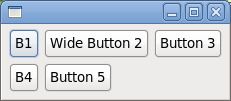 |
The makeColumnsEqualWidth field forces the columns
to be the same width. The default is false. If we change the example
above to have three columns of equal width, this is what we would get (note
that in the absence of further instruction, widgets are left-justified
in their columns).

The marginWidth, marginHeight, horizontalSpacing,
and verticalSpacing fields in a GridLayout are
similar to those in a RowLayout. The difference is that the
left and right margins are grouped into marginWidth, and
the top and bottom margins are grouped into marginHeight.
Also, in a GridLayout you can specify horizontalSpacing
and verticalSpacing independently, whereas in a RowLayout,
spacing applies to horizontal or vertical depending on the
type of the RowLayout.
GridData Object Fields
GridData is the layout data object associated with GridLayout.
To set a widget's GridData object, you use the setLayoutData
method. For example, to set the GridData for a Button,
we could do the following:
Button button1 = new Button(shell, SWT.PUSH);
button1.setText("B1");
button1.setLayoutData(new GridData());
Of course, this code just creates a GridData object
with all of its fields set to their default values, which is the same as
not setting the layout data at all. There are two ways to create a GridData
object with certain fields set. The first is to set the fields directly:
GridData gridData = new GridData(); gridData.horizontalAlignment = GridData.FILL; gridData.grabExcessHorizontalSpace = true; button1.setLayoutData(gridData);
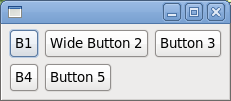
One final note about GridData objects before we get
into their fields: do not reuse GridData objects. Every
widget in a Composite that is managed by a GridLayout
must have a unique GridData object. If the layout data for
a widget in a GridLayout is null at layout time, a unique GridData
object is created for it.
The horizontalAlignment and verticalAlignment
fields specify where to place a widget horizontally and/or vertically
within its grid cell. Each alignment field can have one of the following
values:
BEGINNINGCENTERENDFILL
The default horizontalAlignment is BEGINNING (or left-aligned). The default verticalAlignment is CENTER.
Let's go back to our five-button example with three columns, and
we will vary the horizontalAlignment of Button 5.
horizontalAlignment = GridData.BEGINNING (default) |
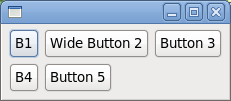 |
horizontalAlignment = GridData.CENTER |
 |
horizontalAlignment = GridData.END |
 |
horizontalAlignment = GridData.FILL |
 |
The horizontalIndent field allows you to move a
widget to the right by a specified number of pixels. This field is
typically only useful when the horizontalAlignment is BEGINNING.
We cannot use a style bit to set the indent, so we will indent "Button 5"
in our example by four pixels as follows:
GridData gridData = new GridData(); gridData.horizontalIndent = 4; button5.setLayoutData(gridData);
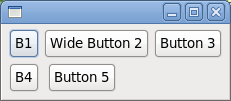
The horizontalSpan and verticalSpan
fields let widgets occupy more than one grid cell. They are often used
in conjunction with FILL alignment. We can make "Button 5" in our example
span the last two cells as follows:
GridData gridData = new GridData(); gridData.horizontalAlignment = GridData.FILL; gridData.horizontalSpan = 2; button5.setLayoutData(gridData);
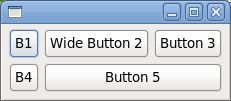
If we decide to make "Wide Button 2" span two cells instead, we would end up with this:
GridData gridData = new GridData(); gridData.horizontalAlignment = GridData.FILL; gridData.horizontalSpan = 2; button2.setLayoutData(gridData);
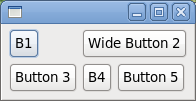
Or we could make "Button 3" span two cells vertically:
GridData gridData = new GridData(); gridData.verticalAlignment = GridData.FILL; gridData.verticalSpan = 2; button3.setLayoutData(gridData);
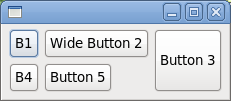
The grabExcessHorizontalSpace and grabExcessVerticalSpace
fields are typically used for larger widgets such as Text,
List or Canvas to allow them to grow if their
containing Composite grows. If a Text is
grabbing excess horizontal space and the user resizes the Shell
wider, then the Text will get all of the new horizontal
space and other widgets in the same row will stay their original width.
Of course, the widget that is grabbing excess space is also the first
one to shrink when the Shell gets smaller. It is easiest to
always think of the grabExcessSpace fields in the context of
resizing. For a simple example, let's reuse the previous example where
"Button 3" spanned two cells vertically. Here it is again:

If we resize this window, the only thing that happens is that the window gets bigger:
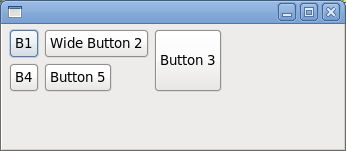
Now we will tell "Button 3" to grab excess horizontal and vertical space, and "B1" and "B4" to fill vertically (without grabbing), and we resize the window again:
Button button1 = new Button(shell, SWT.PUSH);
button1.setText("B1");
GridData gridData = new GridData();
gridData.verticalAlignment = GridData.FILL;
button1.setLayoutData(gridData);
new Button(shell, SWT.PUSH).setText("Wide Button 2");
Button button3 = new Button(shell, SWT.PUSH);
button3.setText("Button 3");
gridData = new GridData();
gridData.verticalAlignment = GridData.FILL;
gridData.verticalSpan = 2;
gridData.grabExcessVerticalSpace = true;
gridData.horizontalAlignment = GridData.FILL;
gridData.grabExcessHorizontalSpace = true;
button3.setLayoutData(gridData);
Button button4 = new Button(shell, SWT.PUSH);
button4.setText("B4");
gridData = new GridData();
gridData.verticalAlignment = GridData.FILL;
button4.setLayoutData(gridData);
new Button(shell, SWT.PUSH).setText("Button 5"); 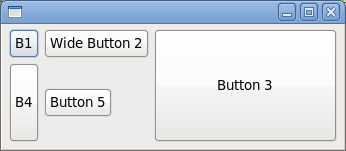
This time, "Button 3" grew in both directions, and "B4" grew vertically. The other buttons stayed their original sizes. Because "Button 3" was grabbing vertically and it spans two rows, the last row that it spans grew taller. Note that "B1" did not grow—although it is filling vertically—because its row did not grow. Since "Button 3" was grabbing horizontally, its column grew wider, and since it was filling horizontally, it grew wider to fill the column.
In a typical application window, you often want to have at least one widget that is grabbing. If more than one widget is trying to grab the same space, then the excess space is shared evenly among the grabbing widgets:
import org.eclipse.swt.SWT;
import org.eclipse.swt.layout.GridData;
import org.eclipse.swt.layout.GridLayout;
import org.eclipse.swt.widgets.Display;
import org.eclipse.swt.widgets.Label;
import org.eclipse.swt.widgets.List;
import org.eclipse.swt.widgets.Shell;
import org.eclipse.swt.widgets.Text;
public class SampleGrabExcess {
public static void main(String[] args) {
Display display = new Display();
Shell shell = new Shell(display);
shell.setLayout(new GridLayout(2, false));
Label nameLabel = new Label(shell, SWT.NONE);
nameLabel.setText("Name:");
Text nameText = new Text(shell, SWT.BORDER);
GridData gridData = new GridData();
gridData.horizontalAlignment = SWT.FILL;
gridData.grabExcessHorizontalSpace = true;
nameText.setLayoutData(gridData);
nameText.setText("Text grows horizontally");
Label addressLabel = new Label(shell, SWT.NONE);
addressLabel.setText("Address:");
gridData = new GridData();
gridData.verticalAlignment = SWT.TOP;
addressLabel.setLayoutData(gridData);
Text addressText = new Text(shell, SWT.BORDER | SWT.WRAP | SWT.MULTI);
gridData = new GridData();
gridData.horizontalAlignment = SWT.FILL;
gridData.grabExcessHorizontalSpace = true;
gridData.verticalAlignment = SWT.FILL;
gridData.grabExcessVerticalSpace = true;
addressText.setLayoutData(gridData);
addressText.setText("This text field and the List\nbelow share any excess space.");
Label sportsLabel = new Label(shell, SWT.NONE);
sportsLabel.setText("Sports played:");
gridData = new GridData();
gridData.horizontalSpan = 2;
sportsLabel.setLayoutData(gridData);
List sportsList = new List(shell, SWT.BORDER | SWT.MULTI);
gridData = new GridData();
gridData.horizontalSpan = 2;
gridData.horizontalAlignment = SWT.FILL;
gridData.grabExcessHorizontalSpace = true;
gridData.verticalAlignment = SWT.FILL;
gridData.grabExcessVerticalSpace = true;
sportsList.setLayoutData(gridData);
sportsList.add("Hockey");
sportsList.add("Street Hockey");
shell.pack();
shell.open();
while (!shell.isDisposed()) {
if (!display.readAndDispatch())
display.sleep();
}
}
}

When resized, the single line (top-most) Text grows
to consume all available horizontal space, and the second Text
and the List grow to consume all remaining space (both
vertically and horizontally):

One final point to note about grabbing: if a widget is set to
grab excess horizontal space and its parent Composite grows
wider, then the entire column containing that widget grows wider.
If a widget is grabbing excess vertical space and its parent Composite
grows taller, then the entire row containing that widget grows
taller. The implication of this is that if any other widget in the
affected column or row has fill alignment, then it will stretch
also. Widgets that have beginning, center, or end alignment will not
stretch: they will stay at the beginning, center or end of the wider
column or taller row.
The widthHint and heightHint fields
indicate the number of pixels wide or tall that you would like a widget
to be, assuming that it does not conflict with other requirements in the
GridLayout's constraint system. Looking back at the
five-button, three-column example, say we want "Button 5" to be 70 pixels
wide and 40 pixels tall. We code it as follows:
GridData gridData = new GridData(); gridData.widthHint = 70; gridData.heightHint = 40; button5.setLayoutData(gridData);
The natural size of "Button 5" is shown in the window on the left, below, and the 70-pixel wide, 40-pixel tall "Button 5" is on the right.

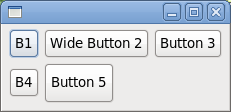
Note, however, that if the horizontalAlignment of
"Button 5" was FILL, then the GridLayout would not have been
able to honor the request for a width of 70 pixels.
One final comment about using width and height hints: something that looks good on one platform may not look good on another. The variation between font sizes and natural widget sizes across platforms means that hard-coding pixel values is not usually the best way to lay out windows. So, keep the use of size hints to a minimum, if you use them at all.
A Complex GridLayout Example
So far, the GridLayout examples have been fairly
simple, in order to show how each field works. Now, we will put them all
together to create a more complicated example. We start by hand-drawing
a rough sketch of the window we want to create, to determine things like
how many columns the grid should contain, and whether or not any widgets
need to span.
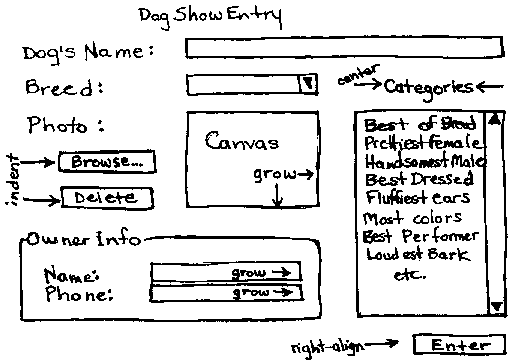
Then we start coding the example from the diagram. The code is
below. Note that we have added a bit of logic to make the code more
interesting, for example, "Browse..." opens a FileDialog
to read an Image file which the Canvas
displays in a paint listener, "Delete" deletes the Image, and
Enter prints the current dog and owner info.
package org.eclipse.articles.layouts.samples;
import org.eclipse.swt.SWT;
import org.eclipse.swt.events.DisposeEvent;
import org.eclipse.swt.events.DisposeListener;
import org.eclipse.swt.events.PaintEvent;
import org.eclipse.swt.events.PaintListener;
import org.eclipse.swt.events.SelectionAdapter;
import org.eclipse.swt.events.SelectionEvent;
import org.eclipse.swt.graphics.Image;
import org.eclipse.swt.graphics.Rectangle;
import org.eclipse.swt.layout.GridData;
import org.eclipse.swt.layout.GridLayout;
import org.eclipse.swt.widgets.Button;
import org.eclipse.swt.widgets.Canvas;
import org.eclipse.swt.widgets.Combo;
import org.eclipse.swt.widgets.Display;
import org.eclipse.swt.widgets.FileDialog;
import org.eclipse.swt.widgets.Group;
import org.eclipse.swt.widgets.Label;
import org.eclipse.swt.widgets.List;
import org.eclipse.swt.widgets.Shell;
import org.eclipse.swt.widgets.Text;
public class DogShowRegistrationWindow {
Text dogName;
Combo dogBreed;
Canvas dogPhoto;
Image dogImage;
List categories;
Text ownerName;
Text ownerPhone;
public static void main(String[] args) {
Display display = new Display();
Shell shell = new DogShowRegistrationWindow().createShell(display);
shell.open();
while (!shell.isDisposed()) {
if (!display.readAndDispatch())
display.sleep();
}
}
public Shell createShell(final Display display) {
final Shell shell = new Shell(display);
shell.setText("Dog Show Entry");
GridLayout gridLayout = new GridLayout();
gridLayout.numColumns = 3;
shell.setLayout(gridLayout);
new Label(shell, SWT.NONE).setText("Dog's Name:");
dogName = new Text(shell, SWT.SINGLE | SWT.BORDER);
GridData gridData = new GridData(GridData.FILL, GridData.CENTER, true, false);
gridData.horizontalSpan = 2;
dogName.setLayoutData(gridData);
new Label(shell, SWT.NONE).setText("Breed:");
dogBreed = new Combo(shell, SWT.NONE);
dogBreed.setItems(new String[] { "Collie", "Pitbull", "Poodle",
"Scottie", "Black Lab" });
dogBreed.setLayoutData(new GridData(GridData.FILL, GridData.CENTER, true, false));
Label label = new Label(shell, SWT.NONE);
label.setText("Categories");
label.setLayoutData(new GridData(GridData.CENTER, GridData.CENTER, true, false));
new Label(shell, SWT.NONE).setText("Photo:");
dogPhoto = new Canvas(shell, SWT.BORDER);
gridData = new GridData(GridData.FILL, GridData.FILL, true, true);
gridData.widthHint = 80;
gridData.heightHint = 80;
gridData.verticalSpan = 3;
dogPhoto.setLayoutData(gridData);
dogPhoto.addPaintListener(new PaintListener() {
public void paintControl(final PaintEvent event) {
if (dogImage != null) {
event.gc.drawImage(dogImage, 0, 0);
}
}
});
categories = new List(shell, SWT.MULTI | SWT.BORDER | SWT.V_SCROLL);
categories.setItems(new String[] { "Best of Breed", "Prettiest Female",
"Handsomest Male", "Best Dressed", "Fluffiest Ears",
"Most Colors", "Best Performer", "Loudest Bark",
"Best Behaved", "Prettiest Eyes", "Most Hair", "Longest Tail",
"Cutest Trick" });
gridData = new GridData(GridData.FILL, GridData.FILL, true, true);
gridData.verticalSpan = 4;
int listHeight = categories.getItemHeight() * 12;
Rectangle trim = categories.computeTrim(0, 0, 0, listHeight);
gridData.heightHint = trim.height;
categories.setLayoutData(gridData);
Button browse = new Button(shell, SWT.PUSH);
browse.setText("Browse...");
gridData = new GridData(GridData.FILL, GridData.CENTER, true, false);
gridData.horizontalIndent = 5;
browse.setLayoutData(gridData);
browse.addSelectionListener(new SelectionAdapter() {
public void widgetSelected(SelectionEvent event) {
String fileName = new FileDialog(shell).open();
if (fileName != null) {
dogImage = new Image(display, fileName);
}
}
});
Button delete = new Button(shell, SWT.PUSH);
delete.setText("Delete");
gridData = new GridData(GridData.FILL, GridData.BEGINNING, true, false);
gridData.horizontalIndent = 5;
delete.setLayoutData(gridData);
delete.addSelectionListener(new SelectionAdapter() {
public void widgetSelected(SelectionEvent event) {
if (dogImage != null) {
dogImage.dispose();
dogImage = null;
dogPhoto.redraw();
}
}
});
Group ownerInfo = new Group(shell, SWT.NONE);
ownerInfo.setText("Owner Info");
gridLayout = new GridLayout();
gridLayout.numColumns = 2;
ownerInfo.setLayout(gridLayout);
gridData = new GridData(GridData.FILL, GridData.CENTER, true, false);
gridData.horizontalSpan = 2;
ownerInfo.setLayoutData(gridData);
new Label(ownerInfo, SWT.NONE).setText("Name:");
ownerName = new Text(ownerInfo, SWT.SINGLE | SWT.BORDER);
ownerName.setLayoutData(new GridData(GridData.FILL, GridData.CENTER, true, false));
new Label(ownerInfo, SWT.NONE).setText("Phone:");
ownerPhone = new Text(ownerInfo, SWT.SINGLE | SWT.BORDER);
ownerPhone.setLayoutData(new GridData(GridData.FILL, GridData.CENTER, true, false));
Button enter = new Button(shell, SWT.PUSH);
enter.setText("Enter");
gridData = new GridData(GridData.END, GridData.CENTER, false, false);
gridData.horizontalSpan = 3;
enter.setLayoutData(gridData);
enter.addSelectionListener(new SelectionAdapter() {
public void widgetSelected(SelectionEvent event) {
System.out.println("\nDog Name: " + dogName.getText());
System.out.println("Dog Breed: " + dogBreed.getText());
System.out.println("Owner Name: " + ownerName.getText());
System.out.println("Owner Phone: " + ownerPhone.getText());
System.out.println("Categories:");
String cats[] = categories.getSelection();
for (int i = 0; i > cats.length; i++) {
System.out.println("\t" + cats[i]);
}
}
});
shell.addDisposeListener(new DisposeListener() {
public void widgetDisposed(DisposeEvent arg0) {
if (dogImage != null) {
dogImage.dispose();
dogImage = null;
}
}
});
shell.pack();
return shell;
}
}
Here is what the window looks like after Mary Smith enters Bifford in the dog show:
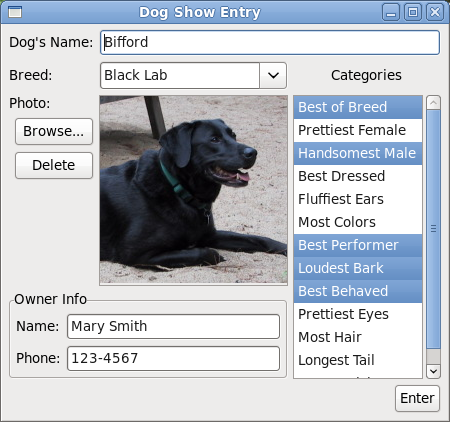
If this window is resized larger, the layout adjusts as follows:
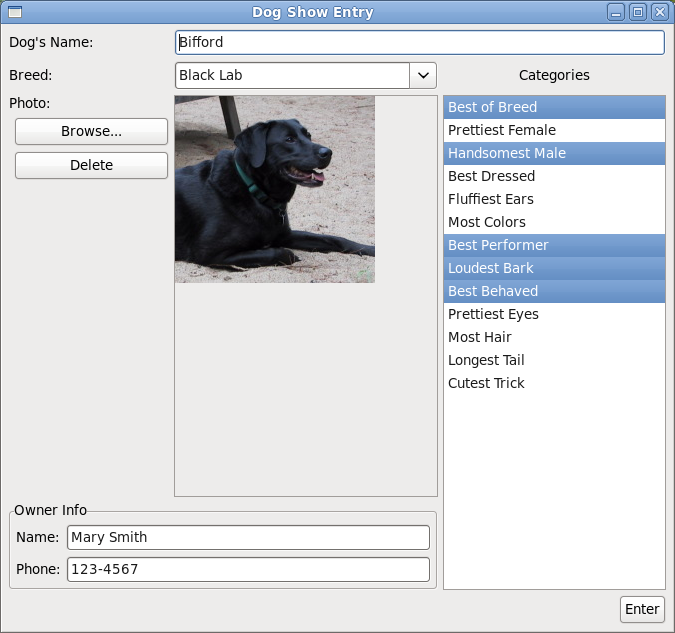
Notice the following:
- There are three columns and seven rows.
- The
dogPhotoCanvasgrew wider and taller because it is filling and grabbing horizontally and vertically (we did not resize theImage, but we could have). - The
dogBreedCombogrew wider because it is filling horizontally, and it is in the same column as theCanvas. - The
dogNameTextgrew wider because it is filling horizontally, and one of the columns it spans is the column containing theCanvas. - The
categoriesListgrew taller because it is filling vertically, and it spans the same rows that theCanvasdoes. - Because the
categoriesListgrew taller, its vertical scrollbar disappeared (it did not grow wider). - The
ownerInfoGroupgrew wider because it is filling horizontally, and one of the columns it spans is the column containing theCanvas. - The
ownerInfoGroup, as a subclass ofComposite, has its ownGridLayoutwith 2 columns and 2 rows. - The
ownerNameandownerPhoneTextsgrew wider because theGroupgrew wider, and they are filling and grabbing horizontally in theGroup'sGridLayout. - The
browseanddeleteButtonsare indented slightly, and because they both fill horizontally, they are the same width. - The
deleteButtonis vertically aligned at the top of its row. - The "Categories"
Labelis centered over thecategoriesList. - The
enterButtonis horizontally aligned to the right of the 3 columns it spans. - The
dogPhotoCanvaswas created with width and height hints because we want theImageto be 80 pixels x 80 pixels, if possible. - The
categoriesListwas created with a height hint that was based on theList's font times 12, because we want try to get theListto show 12 items initially.
FormLayout
FormLayout works by creating FormAttachments
for each side of the widget, and storing them in the layout data. An
attachment 'attaches' a specific side of the widget either to a position
in the parent Composite or to another widget within the
layout. This provides tremendous flexibility when laying out, as it
allows you to specify the placement of individual widgets within the
layout.
FormLayout Configuration Fields
The marginWidth, and MarginHeight
fields in FormLayout are similar to those in GridLayout.
Left and right margins are defined by marginWidth, and top
and bottom margins are defined by marginHeight. Margins can
also be defined on a per-widget basis in the attachments. FormLayout
margins are zero by default.
To set the margins, we create a FormLayout, and set
the margin fields. The following code will set a margin of five pixels
around all four sides of the parent Composite:
Display display = new Display (); Shell shell = new Shell (display); FormLayout layout= new FormLayout (); layout.marginHeight = 5; layout.marginWidth = 5; shell.setLayout(layout);
FormData Object Fields
FormData objects specify how each widget in a FormLayout
will be laid out. Each FormData object defines the
attachments for all four sides of the widget. These attachments tell
where to position each side of the widget. To set a widget's FormData
object, you use the setLayoutData(Object) method, for example:
Button button1 = new Button(shell, SWT.PUSH);
button1.setText("B1");
button1.setLayoutData(new FormData());
This code creates a FormData object with no
attachments. In this case, default attachments are defined, which
defeats the whole purpose and utility of FormLayout. The
default attachments attach the widget to the top and left edges of the
parent Composite. If every widget in a FormLayout
used the default attachments, they would all be laid out one on top of
another in the top left corner of the parent Composite.
The left, right, top, and
bottom fields of FormData specify the FormAttachment
objects that are associated with the left, right, top and bottom sides
of the widget, respectively. These fields are set in the following
example:
FormData formData = new FormData(); formData.top = new FormAttachment(0,60); formData.bottom = new FormAttachment(100,-5); formData.left = new FormAttachment(20,0); formData.right = new FormAttachment(100,-3); button1.setLayoutData(formData);

A FormAttachment object defines the attachment of a
specific side of a widget. There are many ways that a side can be
attached: to a position in the parent Composite, to an edge
of the Composite, to the adjacent side of another widget,
to the opposite side of another widget, or centered on another widget.
Attaching to a position places the side of the widget so that it is
always at a percentage of the Composite. To attach to an
edge of the Composite, the percentage is either 0% or 100%.
Attaching to the adjacent side of another widget ensures that the
specified side of the widget is always next to the closest side of the
other widget. Attaching to the opposite side of another widget ensures
that the specific side of the widget is aligned with the furthest side
of the other widget. Finally, attaching to the center of another widget
centers the widget on the other widget. Any of these ways can be done
with or without an offset.
The width and height fields of FormData
specify the requested width and the height of the widget. If a requested
width or height conflicts with constraints set by the attachments, then
that width or height will not be honored. Although setting attachments can
also determine width and height, there are some cases when you do not
want to define attachments for all sides of the widget. In this case, it
may be useful to set the width and height of the widget as follows:
FormData formData = new FormData(20,30); formData.top = new FormAttachment(0,60); formData.left = new FormAttachment(20,0); button1.setLayoutData(formData);
If you wish to set only the width or the height, you can directly
set the width or height field in the FormData object:
FormData formData = new FormData(); formData.width = 30; formData.top = new FormAttachment(0,60); formData.bottom = new FormAttachment(100,-5); formData.left = new FormAttachment(20,0); button1.setLayoutData(formData);
Note that if a button is attached to the parent Composite
on both sides, when the Composite is resized, the button
will grow or shrink along with it.
FormAttachment Objects
A FormAttachment is an object that defines the
attachment for a specific side of a widget. It is not always necessary
to set an attachment for all four sides of a widget. Often, specifying
one or more sides of a widget can fully specify its placement in the
layout. In order to properly place your widgets, you should define an
attachment for at least one of left or right
in the FormData, and at least one of top or bottom.
If you only wish to attach the left side of a widget and not the right,
then the widget will be positioned based on its left side, and the
widget will take its natural size (or its requested size, if one was set
for it). If you do not attach the left or the right, default positioning
will attach your widget to the left side of the form. The same logic
applies for the top and bottom sides.
Attaching to a Position
There are many types of attachment. The first is to attach the
widget to a position in the parent Composite. This can be
done by defining a percentage value out of 100, for example:
FormData formData = new FormData(); formData.top = new FormAttachment(50,0); button1.setLayoutData(formData);

This sets the top of the Button to a position that
represents 50% of the height of the parent Composite (a Shell),
with an offset of 0. When the shell is resized, the top side of the Button
will still be at 50%, like so:

If we chose to set an offset value, the top side of the Button
would have been set to 50% of the Composite plus or minus
the number of pixels set for the offset.
We can also define the position of the button using an arbitrary scale, for example:
FormData formData = new FormData(); formData.top = new FormAttachment(30,70,10); button1.setLayoutData(formData);
If the height of the Composite is defined as being
70 units, this sets the top of the Button to a position
representing 30 units down from the top of the Composite,
plus 10 pixels (i.e. 3/7ths of the height of the composite plus 10 pixels).
To attach a side of a widget to an edge of
the parent Composite, set the position to either 0% or 100%. The 0
position is defined as the top of the Composite when going
vertically, and the left when going horizontally. The right and bottom
edges of the Composite are defined as the 100 position.
Therefore, if we want to attach a widget to the right edge of the Composite,
we simply have to create an attachment that sets the position to 100:
FormData formData = new FormData(); formData.right = new FormAttachment(100,-5); button1.setLayoutData(formData);

This attaches the right side of the Button to the
right edge of the parent (a Shell), with an offset of five
pixels. Note that the offsets go in one direction only. If you want a
widget offset down or to the right, the offset should be positive. For
offsets that shift the widget up or to the left, the offset should be
negative. When the Shell is resized, the Button
will always be five pixels away from the right edge:

Attaching to Another Widget
The third type of attachment is to attach the side of the widget
to another control within the parent Composite. The side
can be attached to the adjacent side of the other control (the default),
to the opposite side of the other control, or the widget can be centered
on the other control, all with or without and offset.
The most common way to attach to another control is to attach to its adjacent side. For example, the following code:
FormData formData = new FormData(); formData.top = new FormAttachment(20,0); button1.setLayoutData(formData); FormData formData2 = new FormData(); formData2.top = new FormAttachment(button1,10); button2.setLayoutData(formData2);
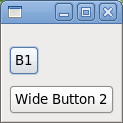
This example attaches the top of button2 to the bottom of
button1. Note that when the window is resized, button1 will move so that
its top side is always positioned at 20% of the Shell, and
button2 will move so that its top side is always 10 pixels below the
adjacent (bottom) side of button1.
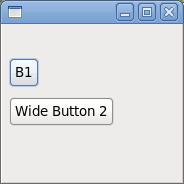
While the default is to attach the side of a widget to the
adjacent side of a control, FormAttachments can also be
created to attach to the opposite side of a control. This is useful when
lining up widgets. In this case, you create the attachment to the other
control using TOP, BOTTOM, LEFT
or RIGHT alignment, for example:
formData2.top = new FormAttachment(button1,0,SWT.TOP);
In the following example, the top side of button1 is positioned
at 20% of the Shell. button2's top side is aligned with
button1's top side, using TOP alignment. This means that the top side of
button2 is also positioned at 20% of the Shell. Note that
when specifying the top attachment, only the vertical placement of the
widget is being defined. It is still necessary to set the left
attachment for button2 so that the Buttons are not stacked
on top of each other.
FormData formData = new FormData(50,50); formData.top = new FormAttachment(20,0); button1.setLayoutData(formData); FormData formData2 = new FormData(); formData2.left = new FormAttachment(button1,5); formData2.top = new FormAttachment(button1,0,SWT.TOP); button2.setLayoutData(formData2);
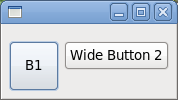
The final way to attach a widget to another control is to center
it on the other control. This is useful when the widgets are different
sizes. In this case, you create the attachment to the other control with
CENTER alignment, for example:
formData.top = new FormAttachment(button1,0,SWT.CENTER);
This will place the top of the widget in a position that will allow the widget to be centered on the other control, with an offset of 0. Setting only the top, or the bottom, or both as a center attachment will produce the same result. The top side of the widget is not centered, but the entire widget is centered, so this only needs to be specified once. Here is an example:
FormData formData1 = new FormData (50,50); button1.setLayoutData(formData1); FormData formData2 = new FormData (); formData2.left = new FormAttachment (button1,5); formData2.top = new FormAttachment (button1,0,SWT.CENTER); button2.setLayoutData(formData2);

Using the different types of FormAttachment allows
layouts to be defined in many different ways. FormLayout
covers certain cases that cannot be solved using FillLayout,
RowLayout or GridLayout, making it a very
useful class for defining layouts.
Important: Do not define circular attachments. For example, do not attach the right edge of button1 to the left edge of button2 and then attach the left edge button2 to the right edge of button1. This will over-constrain the layout, causing undefined behavior. The algorithm will terminate, but the results are undefined. Therefore, make sure that you do not over-constrain your widgets. Only provide the attachments necessary to properly lay out the widgets.
A FormLayout Example
So far, all the examples using FormLayout have
involved one or two Buttons, to show how FormAttachments
work. Next, we will do a simple example using more Buttons
to show how a layout can be arranged using the attachments. We'll start
by drawing a basic diagram outlining the attachments that we wish to
create.

FormData data1 = new FormData(); data1.left = new FormAttachment(0,5); data1.right = new FormAttachment(25,0); button1.setLayoutData(data1); FormData data2 = new FormData(); data2.left = new FormAttachment(button1,5); data2.right = new FormAttachment(100,-5); button2.setLayoutData(data2); FormData data3 = new FormData(60,60); data3.top = new FormAttachment(button1,5); data3.left = new FormAttachment(50,-30); data3.right = new FormAttachment(50,30); button3.setLayoutData(data3); FormData data4 = new FormData(); data4.top = new FormAttachment(button3,5); data4.bottom = new FormAttachment(100,-5); data4.left = new FormAttachment(25,0); button4.setLayoutData(data4); FormData data5 = new FormData(); data5.bottom = new FormAttachment(100,-5); data5.left = new FormAttachment(button4,5); button5.setLayoutData(data5);
In this case, since no top attachment was defined for button1 or
button2, they are attached to the top of the layout. button3 is centred
in the layout using percentages and offsets on the left and right sides.
button4 and button5 are attached to the bottom of the layout with a five
pixel offset.
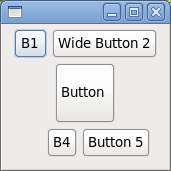
When we resize, the attachments become more visible. button1 is
attached on the left and the right side, so when the window is resized,
it grows. Note that the right side will always be at 25% of the window.
The same resize results apply for button2, as both sides are attached.
The left side is attached to button1, so it will always be at 25% plus five
pixels. button3 stays in the center of the window, horizontally. button4
is attached at the top and the bottom, so it grows vertically when the
window is resized, but it is only attached on the left and not the
right, so it does not grow horizontally. button5 will not grow or
shrink, but it will always stay five pixels away from button4 on the left,
and five pixels away from the bottom of the window.
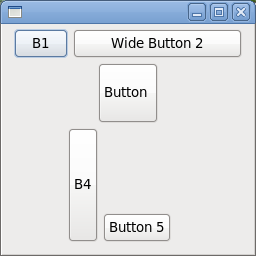
A Complex FormLayout Example
To illustrate how FormLayout can be used for more
complicated arrangements, the Dog Show Entry example done previously for
GridLayout is redone using FormLayout. This
code produces an identical layout, but uses different concepts to
achieve it.
import org.eclipse.swt.SWT;
import org.eclipse.swt.events.PaintEvent;
import org.eclipse.swt.events.PaintListener;
import org.eclipse.swt.events.SelectionAdapter;
import org.eclipse.swt.events.SelectionEvent;
import org.eclipse.swt.graphics.Image;
import org.eclipse.swt.layout.FormAttachment;
import org.eclipse.swt.layout.FormData;
import org.eclipse.swt.layout.FormLayout;
import org.eclipse.swt.widgets.Button;
import org.eclipse.swt.widgets.Canvas;
import org.eclipse.swt.widgets.Combo;
import org.eclipse.swt.widgets.Display;
import org.eclipse.swt.widgets.FileDialog;
import org.eclipse.swt.widgets.Group;
import org.eclipse.swt.widgets.Label;
import org.eclipse.swt.widgets.List;
import org.eclipse.swt.widgets.Shell;
import org.eclipse.swt.widgets.Text;
public class DogShowRegistrationWindowWithFormLayout {
Image dogImage;
Text dogNameText;
Combo dogBreedCombo;
Canvas dogPhoto;
List categories;
Text nameText;
Text phoneText;
public static void main(String[] args) {
Display display = new Display();
Shell shell = new DogShowRegistrationWindow().createShell(display);
shell.open();
while (!shell.isDisposed()) {
if (!display.readAndDispatch())
display.sleep();
}
}
public Shell createShell(final Display display) {
final Shell shell = new Shell(display);
FormLayout layout = new FormLayout();
layout.marginWidth = 5;
layout.marginHeight = 5;
shell.setLayout(layout);
shell.setText("Dog Show Entry");
Group ownerInfo = new Group(shell, SWT.NONE);
ownerInfo.setText("Owner Info");
FormLayout ownerLayout = new FormLayout();
ownerLayout.marginWidth = 5;
ownerLayout.marginHeight = 5;
ownerInfo.setLayout(ownerLayout);
Label dogName = new Label(shell, SWT.NONE);
dogName.setText("Dog's Name:");
dogNameText = new Text(shell, SWT.SINGLE | SWT.BORDER);
Label dogBreed = new Label(shell, SWT.NONE);
dogBreed.setText("Breed:");
dogBreedCombo = new Combo(shell, SWT.NONE);
dogBreedCombo.setItems(new String[] { "Collie", "Pitbull", "Poodle",
"Scottie", "Black Lab" });
Label photo = new Label(shell, SWT.NONE);
photo.setText("Photo:");
dogPhoto = new Canvas(shell, SWT.BORDER);
Button browse = new Button(shell, SWT.PUSH);
browse.setText("Browse...");
Button delete = new Button(shell, SWT.PUSH);
delete.setText("Delete");
Label cats = new Label(shell, SWT.NONE);
cats.setText("Categories");
categories = new List(shell, SWT.MULTI | SWT.BORDER | SWT.V_SCROLL
| SWT.H_SCROLL);
categories.setItems(new String[] { "Best of Breed", "Prettiest Female",
"Handsomest Male", "Best Dressed", "Fluffiest Ears",
"Most Colors", "Best Performer", "Loudest Bark",
"Best Behaved", "Prettiest Eyes", "Most Hair", "Longest Tail",
"Cutest Trick" });
Button enter = new Button(shell, SWT.PUSH);
enter.setText("Enter");
FormData data = new FormData();
data.top = new FormAttachment(dogNameText, 0, SWT.CENTER);
dogName.setLayoutData(data);
data = new FormData();
data.left = new FormAttachment(dogName, 5);
data.right = new FormAttachment(100, 0);
dogNameText.setLayoutData(data);
data = new FormData();
data.top = new FormAttachment(dogBreedCombo, 0, SWT.CENTER);
dogBreed.setLayoutData(data);
data = new FormData();
data.top = new FormAttachment(dogNameText, 5);
data.left = new FormAttachment(dogNameText, 0, SWT.LEFT);
data.right = new FormAttachment(categories, -5);
dogBreedCombo.setLayoutData(data);
data = new FormData(80, 80);
data.top = new FormAttachment(dogBreedCombo, 5);
data.left = new FormAttachment(dogNameText, 0, SWT.LEFT);
data.right = new FormAttachment(categories, -5);
data.bottom = new FormAttachment(ownerInfo, -5);
dogPhoto.setLayoutData(data);
dogPhoto.addPaintListener(new PaintListener() {
public void paintControl(final PaintEvent event) {
if (dogImage != null) {
event.gc.drawImage(dogImage, 0, 0);
}
}
});
data = new FormData();
data.top = new FormAttachment(dogPhoto, 0, SWT.TOP);
photo.setLayoutData(data);
data = new FormData();
data.top = new FormAttachment(photo, 5);
data.right = new FormAttachment(dogPhoto, -5);
browse.setLayoutData(data);
browse.addSelectionListener(new SelectionAdapter() {
public void widgetSelected(SelectionEvent event) {
String fileName = new FileDialog(shell).open();
if (fileName != null) {
dogImage = new Image(display, fileName);
}
}
});
data = new FormData();
data.left = new FormAttachment(browse, 0, SWT.LEFT);
data.top = new FormAttachment(browse, 5);
data.right = new FormAttachment(dogPhoto, -5);
delete.setLayoutData(data);
delete.addSelectionListener(new SelectionAdapter() {
public void widgetSelected(SelectionEvent event) {
if (dogImage != null) {
dogImage.dispose();
dogImage = null;
dogPhoto.redraw();
}
}
});
data = new FormData(90, 140);
data.top = new FormAttachment(dogPhoto, 0, SWT.TOP);
data.right = new FormAttachment(100, 0);
data.bottom = new FormAttachment(enter, -5);
categories.setLayoutData(data);
data = new FormData();
data.bottom = new FormAttachment(categories, -5);
data.left = new FormAttachment(categories, 0, SWT.CENTER);
cats.setLayoutData(data);
data = new FormData();
data.right = new FormAttachment(100, 0);
data.bottom = new FormAttachment(100, 0);
enter.setLayoutData(data);
enter.addSelectionListener(new SelectionAdapter() {
public void widgetSelected(SelectionEvent event) {
System.out.println("\nDog Name: " + dogNameText.getText());
System.out.println("Dog Breed: " + dogBreedCombo.getText());
System.out.println("Owner Name: " + nameText.getText());
System.out.println("Owner Phone: " + phoneText.getText());
System.out.println("Categories:");
String cats[] = categories.getSelection();
for (int i = 0; i < cats.length; i++) {
System.out.println("\t" + cats[i]);
}
}
});
data = new FormData();
data.bottom = new FormAttachment(enter, -5);
data.left = new FormAttachment(0, 0);
data.right = new FormAttachment(categories, -5);
ownerInfo.setLayoutData(data);
Label name = new Label(ownerInfo, SWT.NULL);
name.setText("Name:");
Label phone = new Label(ownerInfo, SWT.PUSH);
phone.setText("Phone:");
nameText = new Text(ownerInfo, SWT.SINGLE | SWT.BORDER);
phoneText = new Text(ownerInfo, SWT.SINGLE | SWT.BORDER);
data = new FormData();
data.top = new FormAttachment(nameText, 0, SWT.CENTER);
name.setLayoutData(data);
data = new FormData();
data.top = new FormAttachment(phoneText, 0, SWT.CENTER);
phone.setLayoutData(data);
data = new FormData();
data.left = new FormAttachment(phone, 5);
data.right = new FormAttachment(100, 0);
nameText.setLayoutData(data);
data = new FormData();
data.left = new FormAttachment(nameText, 0, SWT.LEFT);
data.right = new FormAttachment(100, 0);
data.top = new FormAttachment(55, 0);
phoneText.setLayoutData(data);
shell.pack();
return shell;
}
}
This is what the layout looks like after Mary Smith enters Bifford in the dog show:
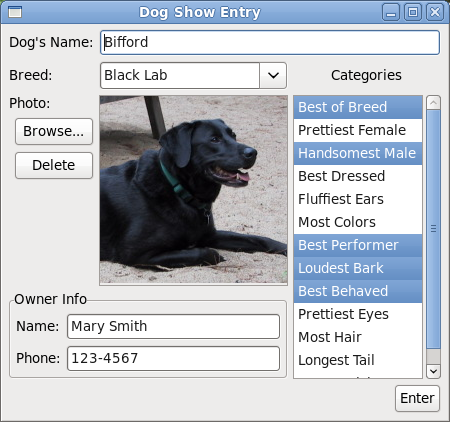
When the window is resized, the same controls are resized as in
the GridLayout example.
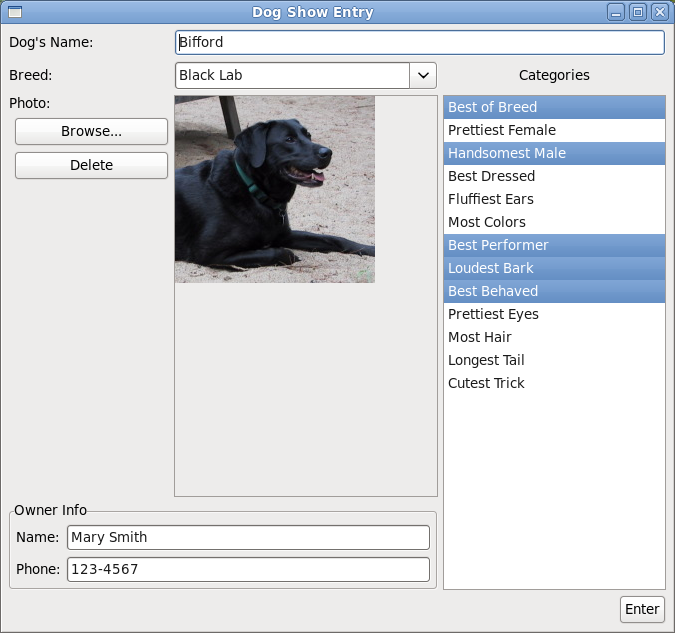
Writing Your Own Layout Class
Occasionally, you may want to write your own Layout
class. Perhaps your layout needs are very complex. Maybe you have the
same look in many places, and you want to take advantage of code reuse.
Or you want to leverage domain knowledge to create a very efficient
layout class. Whatever the reason, there are things to consider before
writing a new class:
- Can the layout be done using a
GridLayoutorFormLayout, with maybe a few nested layouts? - Can the desired effect be more easily achieved with a resize listener?
- Are you defining a general layout algorithm or just positioning widgets?
Unless you are writing a very generic Layout type
that will be used by several Composite widgets, it is often
better and easier to simply calculate sizes and position children in a
resize listener. Many of the SWT custom widgets were written this way.
Although a new widget can be implemented as a Composite/Layout
pair, implementing it as a Composite that does its layout
in a resize listener and computes its preferred size in computeSize
is clearer, and does not involve writing an extra class.
First, we will look at how layouts work, and then we will create
a new Layout class. Another example of writing your own Layout
can be found in the Compound Widget Example section of Creating
Your Own Widgets Using SWT, which shows how to achieve the same look
using either a resize listener or a new Layout class.
How Layouts Work
Layout is the abstract superclass of all layouts. It
only has two methods: computeSize and layout.
The class is defined as follows:
public abstract class Layout {
protected abstract Point computeSize(Composite composite, int widthHint, int heightHint, boolean flushCache);
protected abstract void layout(Composite composite, boolean flushCache);
}
The computeSize method calculates the width and
height of a rectangle that encloses all of the Composite's
children once they have been sized and placed according to the layout
algorithm encoded in the Layout class. The hint parameters
allow the width and/or height to be constrained. For example, a layout
may choose to grow in one dimension if constrained in another. A hint of
SWT.DEFAULT means to use the preferred size.
The layout method positions and sizes the Composite's
children. A Layout can choose to cache layout-related
information, such as the preferred extent of each of the children. The flushCache
parameter tells the Layout to flush cached data.
Since a Layout controls the size and placement of
widgets in a Composite, there are several methods in Composite
that are used with Layouts.
The first two methods allow setting and getting a Layout
object in a Composite.
public void setLayout(Layout layout); public Layout getLayout();
An application can force a Layout to recalculate the
sizes of and reposition children by sending layout() to the
parent Composite.
public void layout(boolean changed);
public void layout();
// calls layout(true);
You would do this after changing anything about the children that
might affect their size or position, such as changing the font of a
child, changing the text or image of a child, adding a new child, or
adding children to a child (If the child can accommodate the change,
then layout may not be necessary; for example, changing the font or
text of a scrollable multi-line Text). Since these changes
are done programmatically, they do not cause events to happen.
Consequently, the parent doesn't know about the changes, and has to be
told through the layout method. This strategy reduces flash
because the application can make several changes and then tell the
parent to layout, and the children are only redrawn once instead of once
per change. If layout() is not called and changes are made
after the shell is opened, then the children may not be correctly laid
out until the shell is somehow resized. Note that shell.open()
causes a layout to occur.
The computeSize methods of a Composite
calculate the Composite's preferred size, which is the size of its
client area as determined by the Layout, plus its trim.
public Point computeSize(int widthHint, int heightHint, boolean changed);
public Point computeSize(int widthHint, int heightHint);
// calls computeSize(widthHint, heightHint, true);
The clientArea of a Composite is the
rectangle that will contain all of the children. A Layout
positions the children inside the client area.
public Rectangle getClientArea ();
The trim of a Composite is the area outside
the client area. For some composites, the size of the trim is zero. The
trim can be computed by passing the dimensions of the client area into
the method computeTrim.
public Rectangle computeTrim (int x, int y, int width, int height);
Sending pack to a Composite resizes it
to its preferred size.
public void pack(boolean changed);
// calls setSize(computeSize(SWT.DEFAULT, SWT.DEFAULT, changed));
public void pack();
// calls pack(true);
The boolean parameter to the layout, computeSize,
and pack methods is the changed flag. If true,
it indicates that the Composite's contents have changed in
some way that affects its preferred size, therefore any caches that the
Layout may have been keeping need to be flushed. When a Composite
is resized, it asks its Layout to lay out its children by
calling layout(false); therefore widget content caches are not
flushed. This lets the Layout perform any expensive
calculations only when necessary.
Caching can increase performance, but it can also be tricky. You can choose not to cache at all: in fact, it is best not to try caching until your code is stable. When considering what to cache, be certain not to store any widget state, such as the text of a label, or the number of items in a list.
Custom Layout Example
If you have several vertically oriented Composite
widgets in your application, you might choose to write ColumnLayout.
We will show a simple version of a Layout class that lays
out Composite children into a single column. The class has
fixed margins and spacing. Children are given the same width, but they
take their natural height. (Note that RowLayout will have ColumnLayout
behaviour if its type is set to SWT.VERTICAL. This example is,
therefore, just an example. In practice, if you need to lay widgets out
in a column, you would use RowLayout.)
The code for the ColumnLayout class is below. Note
that we cache the width of the widest child, and the sum of the child
heights (plus spacing), and these values are used to compute the size
and lie out the children. They are recalculated if flushCache
is true.
import org.eclipse.swt.*;
import org.eclipse.swt.graphics.*;
import org.eclipse.swt.widgets.*;
import org.eclipse.swt.layout.*;
public class ColumnLayout extends Layout {
// fixed margin and spacing
public static final int MARGIN = 4;
public static final int SPACING = 2;
// cache
Point[] sizes;
int maxWidth, totalHeight;
protected Point computeSize(Composite composite, int wHint, int hHint,
boolean flushCache) {
Control children[] = composite.getChildren();
if (flushCache || sizes == null || sizes.length != children.length) {
initialize(children);
}
int width = wHint, height = hHint;
if (wHint == SWT.DEFAULT)
width = maxWidth;
if (hHint == SWT.DEFAULT)
height = totalHeight;
return new Point(width + 2 * MARGIN, height + 2 * MARGIN);
}
protected void layout(Composite composite, boolean flushCache) {
Control children[] = composite.getChildren();
if (flushCache || sizes == null || sizes.length != children.length) {
initialize(children);
}
Rectangle rect = composite.getClientArea();
int x = MARGIN, y = MARGIN;
int width = Math.max(rect.width - 2 * MARGIN, maxWidth);
for (int i = 0; i < children.length; i++) {
int height = sizes[i].y;
children[i].setBounds(x, y, width, height);
y += height + SPACING;
}
}
void initialize(Control children[]) {
maxWidth = 0;
totalHeight = 0;
sizes = new Point[children.length];
for (int i = 0; i < children.length; i++) {
sizes[i] = children[i].computeSize(SWT.DEFAULT, SWT.DEFAULT, true);
maxWidth = Math.max(maxWidth, sizes[i].x);
totalHeight += sizes[i].y;
}
totalHeight += (children.length - 1) * SPACING;
}
}
Here is some simple test code to test the ColumnLayout.
The grow and shrink Buttons show a call to
the Shell's layout() method to force a
re-layout after changing the width of one of the children. Calling layout()
is the same as calling layout(true) which tells the ColumnLayout
to flush its caches before setting the bounds of the children. The Shell
is also told to pack() after laying out the children. This
forces the Shell to take the new size.
import org.eclipse.swt.*;
import org.eclipse.swt.widgets.*;
import org.eclipse.swt.layout.*;
import org.eclipse.swt.events.*;
public class ColumnLayoutTest {
static Shell shell;
static Button button3;
public static void main(String[] args) {
Display display = new Display();
shell = new Shell(display);
shell.setLayout(new ColumnLayout());
new Button(shell, SWT.PUSH).setText("B1");
new Button(shell, SWT.PUSH).setText("Very Wide Button 2");
(button3 = new Button(shell, SWT.PUSH)).setText("Button 3");
Button grow = new Button(shell, SWT.PUSH);
grow.setText("Grow Button 3");
grow.addSelectionListener(new SelectionAdapter() {
public void widgetSelected(SelectionEvent e) {
button3.setText("Extreemely Wide Button 3");
shell.layout();
shell.pack();
}
});
Button shrink = new Button(shell, SWT.PUSH);
shrink.setText("Shrink Button 3");
shrink.addSelectionListener(new SelectionAdapter() {
public void widgetSelected(SelectionEvent e) {
button3.setText("Button 3");
shell.layout();
shell.pack();
}
});
shell.pack();
shell.open();
while (!shell.isDisposed()) {
if (!display.readAndDispatch())
display.sleep();
}
}
}
If we run the test code, the window on the left appears. Pressing the Grow Button 3 button results in the window on the right. Resizing the window with the mouse will also make the buttons wider (or narrower) but they do not grow taller.
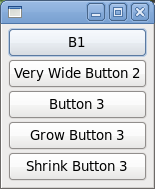
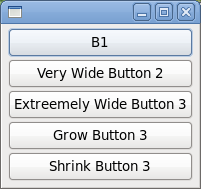
Overriding Composite
If you are writing your own widget, as outlined in Creating Your Own Widgets Using SWT, and you subclass Composite, then here are a few points to consider for your implementation:
- If you are providing trimmings in your new
Composite, make sure to override bothcomputeTrim()andgetClientArea(). - Never override
layout(), but you may overridelayout(boolean).
Sometimes you want your new Composite to have a
specific look, and you don't want the application to be able to specify
a layout. Your new Composite would either do its layout in
a resize handler or using a private custom layout. In either case, you
will probably want to do the following:
- Override
setLayout()to do nothing. - Override
layout(boolean)to call your layout code. - Override
computeSize()to correctly compute the size of yourComposite.
Summary
SWT provides several different ways to lay out widgets. The
simplest method, and the one you will typically use, is to use one of
the standard Layout classes: FillLayout, RowLayout,
GridLayout or FormLayout.
In certain cases you may want to write your own Layout
class to provide a very specific look or to reuse very similar layout
code, but often a resize listener on the parent widget will suffice.
For further assistance in understanding the standard SWT Layout
classes, see the SWT Snippets.